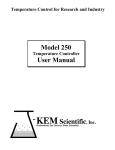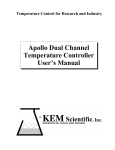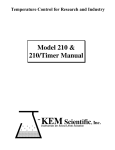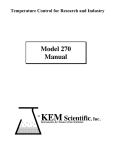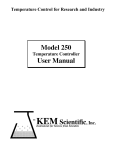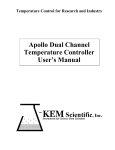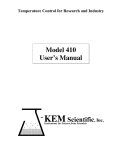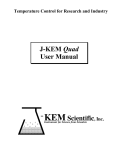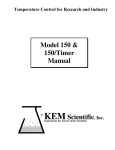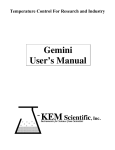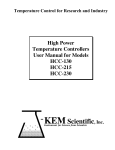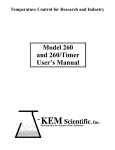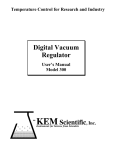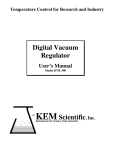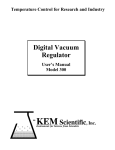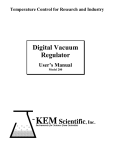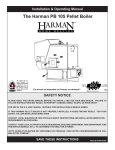Download Model 410 User`s Manual
Transcript
Temperature Control for Research and Industry Model 410 User’s Manual 2 Warranty J-KEM Scientific, Inc. warrants this unit to be free of defects in materials and workmanship and to give satisfactory service for a period of 12 months from date of purchase. If the unit should malfunction, it must be returned to the factory for evaluation. If the unit is found to be defective upon examination by J-KEM, it will be repaired or replaced at no charge. However, this WARRANTY is VOID if the unit shows evidence of having been tampered with or shows evidence of being damaged as a result of excessive current, heat, moisture, vibration, corrosive materials, or misuse. This WARRANTY is VOID if devices other than those specified in Section 3.2 are powered by the controller. Components which wear or are damaged by misuse are not warranted. This includes contact points, fuses and solid state relays. THERE ARE NO WARRANTIES EXCEPT AS STATED HEREIN. THERE ARE NO OTHER WARRANTIES, EXPRESSED OR IMPLIED, INCLUDING BUT NOT LIMITED TO THE IMPLIED WARRANTIES OF MERCHANTABILITY AND OF FITNESS FOR A PARTICULAR PURPOSE. IN NO EVENT SHALL J-KEM SCIENTIFIC, INC. BE LIABLE FOR CONSEQUENTIAL, INCIDENTAL OR SPECIAL DAMAGES. THE BUYER'S SOLE REMEDY FOR ANY BREACH OF THIS AGREEMENT BY J-KEM SCIENTIFIC, INC. OR ANY BREACH OF ANY WARRANTY BY J-KEM SCIENTIFIC, INC. SHALL NOT EXCEED THE PURCHASE PRICE PAID BY THE PURCHASER TO J-KEM SCIENTIFIC, INC. FOR THE UNIT OR UNITS OF EQUIPMENT DIRECTLY AFFECTED BY SUCH BREACH. Service J-KEM Scientific maintains its own service facility and technical staff to service all parts of the controller, usually in 24 hours. For service, contact: J-KEM Scientific, Inc. 6970 Olive Boulevard St. Louis, MO 63130 USA (314) 863-5536 FAX (314) 863-6070 Web site: http://www.jkem.com E-Mail: [email protected] This manual contains parameters specific to temperature controller Serial #_________________. When calling with a technical question, please have the controller’s serial number available. You’ve purchased the most versatile controller available to the research community. We’re confident it can regulate ANY heating/cooling situation you’ll ever encounter. If the information in this manual isn’t adequate to make your application work, call our Engineering Department for assistance. – With J-KEM’s patented Microtune circuitry – 3 INDEX SECTION PAGE 1. QUICK OPERATING INSTRUCTIONS . . . . . . . . . . . . . . . . . . . . . . 4 2. ADJUSTING THE CONTROLLER FOR STABLE CONTROL WITH DIFFERENT HEATERS . . . . . . . . . . . . . . . . . . . . 2.1 What is Tuning . . . . . . . . . . . . . . . . . . . . . . . . . . . . . . . . . . . . . . . . . 2.2 Autotuning Procedure . . . . . . . . . . . . . . . . . . . . . . . . . . . . . . . . . . 2.3 Tuning for Heating Mantles and Oil Baths: Special Cases . . . . . . . 2.4 Sensor Placement . . . . . . . . . . . . . . . . . . . . . . . . . . . . . . . . . . . . . . 5 5 6 8 8 3. OPERATIONS GUIDE . . . . . . . . . . . . . . . . . . . . . . . . . . . . . . . . . . . . . 3.1 Front Panel Description . . . . . . . . . . . . . . . . . . . . . . . . . . . . . . . . . 3.2 Heater Restrictions . . . . . . . . . . . . . . . . . . . . . . . . . . . . . . . . . . . . . 3.3 Ramp-to-Setpoint & Soak Feature . . . . . . . . . . . . . . . . . . . . . . . . . . 3.4 Temperature Sensor Input . . . . . . . . . . . . . . . . . . . . . . . . . . . . . . . 3.5 Power Reduction Circuit . . . . . . . . . . . . . . . . . . . . . . . . . . . . . . . . 3.6 Effect of Power Setting on Heating Profile . . . . . . . . . . . . . . . . . . 3.7 Resetting the Controller for Use With Heating Mantles & Baths. . . 3.8 Changing between PID and ON/OFF Operating Modes . . . . . . . . 3.9 Troubleshooting . . . . . . . . . . . . . . . . . . . . . . . . . . . . . . . . . . . . . . . 3.10 Do's and Don'ts When Using Your Controller . . . . . . . . . . . . . . . 9 9 10 10 12 12 14 15 16 17 18 4. APPLICATION NOTES . . . . . . . . . . . . . . . . . . . . . . . . . . . . . . . . . . . . 4.1 Theory of How the Controller Works – Simply . . . . . . . . . . . . . . 4.2 Controlling the Heating Mantle Temperature Directly . . . . . . . . . . 4.3 Automatic Storage of Min/Max Temperatures . . . . . . . . . . . . . . . 19 19 21 22 TABLE 1 . . . . . . . . . . . . . . . . . . . . . . . . . . . . . . . . . . . . . . . . . . . . . . . . . 23 APPENDIX . . . . . . . . . . . . . . . . . . . . . . . . . . . . . . . . . . . . . . . . . . . . . . . . . . . 24 I. Safety Considerations and Accurate Temperature Control . . . . . . . . . . . 24 II. Resetting the Controller to Original Factory Settings . . . . . . . . . . . . . . . . 25 WARNING: Adhere to the restrictions of SECTION 3.2. Failure to do so may create a significant safety hazard and will void the warranty. 4 Section 1: Quick Operating Instructions The three steps below are the basics of using your temperature controller. The User’s Manual is a reference that explains the controller more fully as well as some of its more sophisticated features. It’s recommended that new users unfamiliar with process controllers read the entire manual carefully. Users unfamiliar with J-KEM’s temperature controllers should particularly read the safety notices in Appendix I. To use heaters other than heating mantles and oil baths: See Section 2. For polymer synthesis, atypical, expensive, or safety critical reactions: See Appendix I. 1 Place the thermocouple in the solution being heated. Place at least the first 1/4” of the thermocouple 2 Set the power level switch to the correct power setting. Oil Baths - Set the power level switch to the directly in the solution being heated. If the controller is used with an oil bath, the probe should be placed in the oil, if with a flask in a heating mantle, then place the probe in the solution inside the flask. When the probe is in the oil of an oil bath, the oil should be stirred for uniform heat distribution since the oil heats very rapidly. Placing the oil bath on top of a running magnetic stirrer with a stirring bar inside the oil works well. Thermocouples can be bent without harming them. If you’re heating a corrosive liquid, use a Teflon coated thermocouple. If you are heating a sealed reaction, see Section 4.2. 10-100 ml (20v) 50-500 ml (40v) 1-10 ml (10v) 300 ml-2 L (60v) Heat Off > 2 L (110v) TIP: Because the power switch acts like a variac, if the reaction is heating too slowly or you need more power (e.g., heating to high temperatures), give the heater more power by turning the power level up one setting. If the reaction needs less power than normal(e.g., heating to o low temperatures (<60 C) or the temperature overshoots the set point excessively, turn the power down one setting. DO NOT set the power switch on a setting too high initially to heat the reaction quickly and then lower it to the correct setting, this degrades heating performance. Output voltage setting equal to the voltage rating of the PowerLevel oil bath being used (i.e., if a 40 volt bath is being used, set the power level switch to the 40V A power is equivalent to setting). setting of..... a variac setting of: Heating Mantles - Set the power level switch to 1-10 ml 3% the volume of solution being heated, not the size 10-100 ml 10% of the flask. The power level switch can be 25% thought of as a solid state variac. Volume ranges 50-500 ml 50% are printed above this switch as a guide to select 300 ml - 2 L >2L 100% the correct power level since it’s easier to guess the volume being heated than the appropriate “percent power” to apply to a heater. ‘Heat Off’ turns off the heater so the controller displays temperature only. Section 3.5 should be read by all new users. 3 Enter the setpoint (i.e., the desired temperature). Hold in the * button and simultaneously press the UP key to increase or the DOWN key to decrease the setpoint. The setpoint can be seen at anytime by holding in the * button, the setpoint appears as a blinking number in the display. 5 8 0. 0 * Section 2: Adjusting The Controller For Stable Control With Different Heaters 2.1 What is Tuning. The controller's most powerful feature is its ability to regulate virtually any heater with stable temperature control. For stable control the controller requires two things; (1) the controller must be set to the correct power level (see Section 3.5) and, (2) that it must be tuned to the heater being used. Tuning is the process that matches the control characteristics of the controller to the heating characteristics of the heater. The controller is said to be tuned to the heater when its memory is programmed with values telling it how fast the heater warms up, cools off, and how efficiently it transfers heat. For example, consider the difference between a heat lamp and a hot plate. When electricity is applied to a heat lamp it begins to heat instantaneously, and when it's turned off it stops heating instantaneously. In contrast, a hot plate may take several minutes to begin heating when electricity is applied and even longer to start cooling when electricity is turned off. Your controller can o regulate both a heat lamp and a hot plate to 0.1 C. But, to do this it must be programmed with the time constants describing how fast the heater heats when electricity is turned on and how fast it begins to cool when it's turned off. These time constants are called the tuning parameters. Every type of heater has its own unique set of tuning parameters. For the controller to heat with stability, it must have programmed with the tuning parameters for the heater currently being used. Prior to shipment, tuning parameters were programmed into the controller that maximize heating performance for laboratory heating mantles and oil baths since these are the most common heaters used in research. Tuning is regulated by 5 of the temperature meter’s user programmable functions. The correct value for these 5 functions can be calculated and loaded by the user manually, or the controller can do it automatically with its autotune feature When Should the Controller be Tuned? If the controller is tuned to one type of heater, heating mantles for example, any size heating mantle can be used without the need to retune. When changing from heating mantles to a different type of heater, an oven for example, the controller should be tuned with values describing the oven’s heating characteristics. The effect of tuning is seen below. When the controller is tuned for heating mantles, using it with any size heating mantle yields stable temperature control (Plot 1), but poor control results when the same tuning parameters are used with an oven (Plot 2, Curve 1). However, after tuning the controller to the oven, stable temperature control results (Plot 2, Curve 2). Plot 2 Plot 1 80 80 70 70 60 Temp. o C 50 Conditions: 100 ml Toluene 250 ml Round bottomed flask 250 ml Heating mantle Power Setting = 50 - 500 ml 40 40 30 30 20 0 10 20 30 Time (min) 40 50 Curve 2: Controller loaded with tuning parameters for drying oven 60 Temp. o C 50 60 6 Curve 1: Controller loaded with tuning parameters for heating mantles 20 0 10 20 30 40 Time (min) 50 60 It’s important to understand that this controller isn’t a simple ON/OFF type controller (i.e. ON when below the set point, OFF when above [though it can be made to work this way, see Section 3.8]). Rather it’s a predictive controller. Based on the shape (slope) of the heating curve, the controller predicts (calculates) the percent of power to apply to the heater now to control the shape of the heating curve minutes in advance. The importance of the tuning parameters is that they are constants in the equation the temperature meter uses to perform its predictive calculations. If the temperature meter is programmed with tuning parameters that incorrectly describe the heater being used, poor temperature o control will result. But, when the correct values are loaded, temperature regulation of ± 0.1 is typically achieved. Manual Tuning. Manual tuning is when the values of the 5 tuning parameters are determined manually then entered into the temperature meter via the push buttons on the front of the controller. Experienced users might prefer to manually tune the controller since this allows customization of the heating process. Autotune. Autotune is a feature built into the temperature meter that automatically calculates the tuning parameters (i.e. delay times, heating efficiency, etc.) for any type of heater. After the autotune procedure is complete and the tuning parameters are determined, the controller loads them into its memory for current and future use. Heating mantles and oil baths are special cases and are covered in a separate paragraph (Section 2.3). 2.2 Autotuning Procedure. 1. 2. 3. 4. 5. 6. 7. 8. 9. Set the equipment up in the exact configuration it will be used. For example, to tune to a vacuum oven, place the thermocouple in the room temperature oven and plug the oven into the controller. If the oven (or heater) has its own thermostat or power control, turn both as high as they’ll go. Set the controller to the appropriate power level (see Section 3.5). Turn the controller and o heater on, then enter the desired set point temperature. If the set point isn’t at least 30 C above ambient, skip this procedure and go to the next procedure, “Autotuning the Controller for Very Fine Control” Press and hold in both the UP and DOWN buttons (for 3 seconds) on the front of the temperature meter until the word “tunE” appears in the display then release both buttons. Press the UP button (5 times) until “CyC.t” appears in the display (if you go past this setting, press the DOWN button until you get back to it). First, hold in the ‘*’ button, while holding in the ‘*’ button press the DOWN button. Continue to hold both buttons in until the display reads “A --”, or “A ##” where “##” is some number. Release the ‘*’ button and press the UP button until “tunE” once again appears in the display. Press and hold the ‘*’ button and “tunE” will change to “off” to indicate that autotune is currently off. While holding in the ‘*’ button, press the UP button to change the display to “on”, then release both buttons. Press and hold both the UP and DOWN buttons (for 3 seconds) until the temperature appears in the display. The controller is now in its autotune mode. While in autotune the display alternates between “tunE” (for autotune) and the process temperature. When the autotune sequence is done (this may take in excess of an hour) the controller stops displaying “tunE” and only displays the process temperature. [To abort autotune manually, repeat steps 3, 8 and 9 except in step 8 press the DOWN button until “off” is displayed]. 7 New tuning values loaded into memory Temp Set Point 75% of set point Start AT Heat to set point after entering new parameters OS1 OS2 US During T1 - 4 the controller measures heating delays and rates of heating and cooling T1 T2 T3 T4 Quarter cycle times Time The autotune sequence. During autotune the controller heats to 75% of the set point temperature where it oscillates for several cycles before loading the new tuning parameters. After the tuning parameters are loaded it heats to the set point temperature. Tuning below the set point prevents any damage that might occur from overheating. Autotuning the Controller for Very Fine Control. In the majority of cases, the procedure above results in stable temperature control with any heater. A second version of the autotune routine is available and can be used when the heater is already at or close to the set point, is being tuned at a temperature close to room temperature, or for very fine control in demanding situations. If stable temperature control doesn’t result after performing the first autotune routine, the procedure below should be performed. Before performing the ‘fine tune’ autotune procedure, the ‘regular’ autotune procedure that precedes this should normally be performed. 1. Set the equipment up in the exact configuration it will be used. If the heater has its own thermostat or power controls, turn both as high as they’ll go. With this procedure it’s not necessary for the equipment to start at room temperature. This procedure can be performed at any time and any temperature. 2. Set the controller to the appropriate power level (see Section 3.5). Turn the controller and heater on, then enter the desired set point temperature. 3. Press and hold in both the ▲ and ▼ buttons (for 3 seconds) on the front of the temperature meter until the word “tunE” appears in the display then release both buttons. 4. Press the ▲ button (5 times) until “CyC.t” appears in the display (if you go past this setting, press the ▼ button until you get back to it). 5. First hold in the ‘*’ button, while holding in the ‘*’ button press the ▼ button. Continue to hold both buttons in until the display reads “A --”, or “A ##” where “##” is some number. Release the ‘*’ button and press the ▼ button until “ tunE” once again appears in the display. 6. 7. Press and hold the ‘*’ button and “tunE” will change to “off” to indicate that autotune is currently off. 8. While holding in the ‘*’ button, press the ▲ button to change the display to “ At.SP”, then release both buttons. 9. Press and hold both the ▲ and ▼ buttons (≈ 3 seconds) until the temperature appears in the display. The controller is now in its autotune mode. While in autotune the display alternates between “tunE” (for autotune) and the process temperature. When the autotune sequence is done (this may take in excess of an hour) the controller stops displaying “tunE” and only displays the process temperature. [To abort autotune manually, repeat steps 3, 8 and 9 except in step 8 press the ▼ button until “ off” is displayed]. 8 Autotune Errors. The autotune routine can fail for several reasons. If it fails, the controller displays the error message “tunE” “FAiL”. To remove this message turn the controller off for 10 seconds. Try the procedure titled “Autotuning the Controller for Very Fine Control” above. If autotune fails again, call and discuss your application with one of our engineers. A common problem when tuning at high temperatures or with large volumes is for the heater to be underpowered. A more powerful heater may be needed (contact J-KEM for assistance). 2.3 Tuning for Heating Mantles and oil baths: Two Special Cases. This section gives special consideration to heating mantles and oil baths, since they’re the most commonly used heaters in research. When used with a heating mantle, the probe should be in the solution inside the flask, when used with oil baths, the probe should be in the oil in the bath. Every heating mantle and oil bath size has its own optimum set of tuning parameters and if desired, the controller could be tuned (or autotuned) every time a different size is used. However, this is cumbersome and is also unnecessary. Factory tests show that there’s one set of tuning parameters that deliver good performance for all heating mantle and oil bath sizes. These tuning parameters were loaded into the controller at the factory prior to shipping. If you’re using a heating mantle or oil bath and none of the parameters have been changed or the controller hasn’t been autotuned since you’ve received it, you’re ready to go. If the tuning parameters have been changed or the controller has been autotuned and you want to go back to the factory settings, J-KEM recommends that the tuning parameters be loaded manually (i.e., don’t autotune) by following the step-by-step instructions given in Procedure 1 of Section 3.7. If the default parameter set does not result in satisfactory performance, the controller can be autotuned with no detrimental effect. 2.4 Sensor Placement. Placement of the sensor is basically common sense. The sensor should be positioned to sense the average temperature of the medium being heated. That means the thermocouple should be shielded from direct exposure to the heater but not so distant that a rise in temperature isn’t sensed by the controller within a reasonable period of time. Several examples follow that show the type of consideration that should be given to sensor placement. Use With: Solutions HPLC column heated with a heating tape Oven Place the sensor in the solution. Stir vigorously so that heat is homogeneously mixed throughout the solution. Tape a thin wire thermocouple directly to the HPLC column. Place several layers of paper over the thermocouple to insulate it from the heating tape (the thermocouple should sense the column temperature, not the heater temperature). Wrap the HPLC column completely with heating tape. The thermocouple needs to be shielded from transient hot and cold air currents. Don’t place the thermocouple near the heating coil or an air vent. A small thermocouple (1/16” or 1/8” thermocouple) that responds rapidly to changes in air temperature is better than a larger one. 9 Section 3: 3.1 Operations Guide Front Panel Description. 9 - Serial Communications Port (Back) 7 J Instruments -KEM S cie nt ific for Science from Scientists 10-100 ml (20v) 50-500 ml (40v) 1-10 ml (10v) ON Heat Off 8 0. 0 1 8 Output Power Level OFF o 300 ml-2 L (60v) > 2 L (110v) C * 2 6 Mode l410 3 120 Vac, 1800 watts 5 4 Figure 1 1. Temperature Display. Shows temperature of the process as the default display. Shows set point temperature (i.e. desired temperature) when ‘*’ button is pressed. 2. Control Key. When pressed, the display shows the set point temperature. To decrease or increase the set point, press the ‘▼ ’ key (3) or ‘▲ ’ key (4), while simultaneously depressing the control key. The set point appears as a blinking number in the display. 3. Lowers set point when ‘*’ button (2) is simultaneously pressed. 4. Raises set point when ‘*’ button (2) is simultaneously pressed. 5. Temperature Sensor Input. Use the same type of sensor probe as the sensor plug installed on the controller (see Section 3.4). The correct sensor type will have the same color plug as the thermocouple input (5) on the front of the controller. 6. Power Outlet. Plug only 120 VAC devices into this outlet (see Section 3.2). 7. Controller On/Off switch. For maximum display accuracy, turn on the controller 30 minutes prior to use. WARNING: Due to the nature of solid state relays, a small amount of output power (7.5 mA @ 120 VAC; 0.9 watts) is present at outlet 6 even when the controller is turned off. Take appropriate precautions to avoid electrical shock. 8. Power Reduction Circuit. Controls the computer that limits the maximum power delivered to the heater. See Sections 3.5 and 4.1. 9. Optional Serial Port. For controllers equipped for serial communications, this port connects to a PC for remote control and data acquisition. Controllers equipped for RS232 communications have a 9-pin connector, RS485 multi-drop controllers have a RJ-11 phone connector. See supplemental Serial Communications Manual. 10 3.2 Heater Restrictions. The controller delivers 15 amps of current at 120 VAC into resistive loads (heating mantles, oil baths, hot plates, ovens, etc.). Use only resistive loads that are safely operated at 120 VAC and require less than 15 amps or damage to the controller and a safety hazard may result. • When used with an oil bath, do not set the power reduction circuit to a voltage setting higher that the rating for the bath being used. • Devices other than resistive loads can be used with your controller but certain restrictions apply. Device Type Restrictions Comments Incandescent lamps ≤ 1000 watts Infrared heaters Inductive loads: * solenoids * transformers * motors Ramp-to-Setpoint & Soak Feature. A new feature of J-KEM’s controllers called ‘Ramp-To-Setpoint’ allows you to enter a specific heating rate (e.g., heat to 120o C at a rate of 5o C/Hour), a second feature called ‘Soak’ then lets you specify how long to stay at that temperature before turning off. . Examples of Program Ramps Temperature Soak Setpoint Temperature 3.3 ≤ 6 amps; 720 watts The controller must be programmed for this use. Request application note AN5. Ramp Power Off Ramp Soak Setpoint Time Power Off Time The controller is shipped with the Ramp-to-Setpoint feature OFF, the user must specifically turn Ramp-to-Setpoint ON. When Ramp-to-Setpoint is OFF, the controller heats to the entered setpoint at the fastest rate possible. When Ramp-to-Setpoint is ON, the controller heats at the user entered ramp rate. The Ramp-to-Setpoint feature and its associated parameters are turned on and set in the controller’s programming mode. The parameters of importance are: SPrr SetPoint Ramp Rate. Allowable Values: 0 to 9990 deg/Hr. This specifies the desired rate of heating (cooling). Note, this parameter specifies the desired rate of heating (cooling), but in cases of extremely high ramp rates the reaction will not actually heat faster than the power of the heater will allow. 11 SPrn SetPoint Ramp Run. Allowable Values: ON, OFF, Hold This parameter turns the Ramp-to-Setpoint feature ON or OFF. During an active run, if this parameter is set to ‘Hold’, the setpoint ramp stops and holds at its’ current value. This continues until the parameter is set to ON or OFF. When set to OFF, the values in SetPoint Ramp Rate and Soak Time are ignored. SoAK Soak Time. Allowable Values: “- -”, 0 to 1440 min. This specifies the amount of time to soak at the setpoint after the setpoint temperature ramp is complete. A setting of “- -” causes the controller to remain at the final setpoint indefinitely. A numeric value causes the controller to stay at the setpoint for the entered time and then turn power to the heater off after the time expires. Important Points to Know 1. While the Ramp-to-Setpoint feature in activated, the display alternates between the current reaction temperature and the word “SPr” to indicate that a “SetPoint Ramp” is active. 2. Setting a ramp rate doesn’t guarantee that the reaction temperature is at the specified ramp temperature since heating is dependent on the power of the heater. For example, if a ramp rate of 1200 deg/Hr (i.e., 20 deg/min) is set, unless the heater is powerful enough to impart heat at such a high rate, the reaction temperature will not track the ramp temperature. Likewise, a reaction can’t cool faster than natural cooling by ambient air. 3. Once the Ramp-to-Setpoint feature is activated in programming mode, it remains on until it’s deactivated in programming mode. The Ramp-to-Setpoint feature remains activated even if power is turned off to the controller. Activating & Programming the Ramp-to-Setpoint Feature 1. 2. 3. 4. 5. Press and hold in both the ▼ and ▲ keys on the front of the temperature meter until the word “tunE” appears in the display, then release both keys. Press the ▲ key (8 times) until the word “SPrr” appears in the display. This is were you set the ramp rate in units of degrees/hour. First hold in the ‘*’ key, then while holding in the *’ key press the ▼ or ▲ key until the desired ramp rate appears in the display, then let go of all the keys. Units are in degrees/hour. Press the ▲ key once and the word “SPrn” will appear in the display. This function turns the ramping feature ON, OFF, or to Hold. First hold in the ‘*’ key, then while holding in the *’ key press the ▼ or ▲ key until the desired setting appears in the display, then let go of all the keys. Press the ▲ key once and the word “SoaK” will appear in the display. This is where the soak time is set in units of Minutes. A soak time of ‘ -- ‘ means to ‘soak forever’ (this setting is one below ‘0’). First hold in the ‘*’ key, then while holding in the *’ key press the ▼ or ▲ key until the desired time appears in the display, then let go of all the keys. If a soak time is set, the controller display will alternate between showing the current reaction temperature and the word “StoP” when the soak time has expired to indicate that power has been turned off. To exit programming mode, press and hold in both the ▼ and ▲ keys until the temperature appears in the display, then release both keys. Deactivating the Ramp-to-Setpoint Feature 1. 2. 3. Press and hold in both the ▼ and ▲ keys on the front of the temperature meter until the word “tunE” appears in the display, then release both keys. Press the ▲ key (9 times) until the word “SPrn” appears in the display. This function turns the ramping feature ON and OFF. First hold in the ‘*’ key, then while holding in the *’ key press the ▼ or ▲ key until OFF appears in the display, then let go of all the keys. To exit programming mode, press and hold in both the ▼ and ▲ keys until the temperature appears in the display, then release both keys. 12 3.4 Temperature Sensor Input. Every controller is fitted with a specific type of thermocouple input and can only be used with a thermocouple of the same type. For the correct temperature to be displayed, the thermocouple type must match the receptacle type on the front of the controller (Figure 1; # 5). All thermocouples are color coded to show their type (Blue = type T; Yellow = type K; Black = type J). The color of the thermocouple plug must match the color of the receptacle on the front of the controller. If the thermocouple is broken or becomes unplugged, the error message "inPt" "FAiL" blinks in the temperature meter display and the controller stops heating. 3.5 Power Reduction Circuit. This circuit (8) is the interface to J-KEM’s patented power control computer which limits the maximum output power delivered by the controller. It determines whether the controller heats at a very low [(10V) 1-10 mL], low [(20V) 10 - 100 mL], intermediate [(40V) 50 - 500 mL], medium [(60V) 300 mL - 2 L], or high [(110V) >2 L] power level. The power reduction circuit acts as a solid state variac. This circuit has an additional setting: “Heat Off” which, when selected, turns heating off and allows the controller to act as a digital thermometer. The table to the right shows the maximum output power from the controller to the heater depending on the position of the power switch. The correct setting for this switch is the setting that supplies adequate power for the heater to heat to the set point in a reasonable period of time while at the same time not overpowering it. Heating Liquids. Each power level is associated Front Panel Approx. % of with a volume range which acts as a guide when heating Volume Range Full Power solutions with heating mantles. When solutions are 1 - 10 mL 3 heated with heating mantles set the power switch to the 10 - 100 mL 10 range that includes the volume of solution being heated 50 - 500 mL 25 [Note: this switch is set to the volume of solution, not 300 ml - 2 L 50 the size of the flask]. For example to heat 250 ml of ≥2 L 100 toluene to 80o C in a 1 L round bottomed flask choose the third power setting (50 - 500 ml) since the solution volume falls within this range. There are situations when a power level other than that indicated on the front panel should be used: Example 80 ml toluene 100 ml flask 100 ml heating mantle SP = 80o C 80 ml collidine 100 ml flask 100 ml heating mantle SP = 170o C Power Setting 50 - 500 ml (25% power) 300 ml - 2 L (50% power) Explanation Organic solvents heated to ≈ 50 - 110o C are set to the volume range on the front panel. When choosing between 2 power settings (i.e. 80 ml also falls within both the 10 - 100 ml range and the 50 - 500 ml range) choose the higher setting. Even though the solvent volume is less than the range of this power setting, it should be used because high temperatures require additional power. 13 80 ml water 100 ml flask 100 ml heating mantle SP = 80o C 125 ml toluene 1 L flask 1 L heating mantle SP = 80o C 150 ml toluene 250 ml flask 250 ml heating mantle SP = 35o C 300 ml - 2 L (50% power) 10 - 100 ml (10% power) 10 - 100 ml (10% power) While the setting 50 - 500 ml would work, since the heat capacity of water is twice that of a typical organic solvent (1 cal/g/o K), a higher power setting can be used to compensate for the higher heat capacity. When the heating mantle size is substantially larger (≥ 5X) than the volume being heated (i.e. the heating mantle has excess heating capacity for the volume being heated), a lower power setting gives better control. Even though the solvent volume isn’t included in this power setting, it should be used because low temperatures are better regulated with less power. Avoid switching between power levels while the controller is heating. Specifically, do not initially set the controller on a high power level to rapidly heat the solution, then decrease the power level to the correct setting as the solution approaches the set point. Changing power levels doesn’t damage the controller, but it will reduce its heating performance. Heating Oil Baths. Set the power level switch to the voltage position that equals the voltage rating of the bath. You should set the power level switch one voltage setting lower than the rating of the bath if heating to temperatures below 60o C. For example, to heat a bath rated at 40 volts to 45o C, set the power level switch one setting below the 40 volt setting (i.e., set to the 20 volt setting). Heating Equipment. Two factors need to be considered when heating equipment (ovens, hot plates, furnaces, HPLC columns, etc.); (1) placement of the temperature sensor (Section 2.4) and, (2) the appropriate power setting. The best guide to the correct power setting for various pieces of equipment is the researcher's experience. If your best guess is that the equipment needs 1/3 full power to heat to the set point, set the power switch on the 300 ml - 2 L setting (i.e., 50% power, it’s usually better to have too much power rather than too little). If the heater heats too slow, increase the power (to the >2 L setting), if it heats too fast or has excessive overshoot, decrease the power (to the 50 - 500 ml setting). If the amount of power seems to be adequate, but the heater doesn’t heat with stability, the controller probably needs to be tuned (see Section 2). Section 3.6 shows the type of performance you should expect from the controller with different pieces of equipment. 14 3.6 Effect of Power Setting on Heating Profile. The following graphs show the effect of selected power levels on heating performance in a variety of situations. Each example contains 1 optimal and 1 or 2 less optimal settings demonstrating use of the power reduction circuit. 80 Graph 1 70 Conditions: Set point = 75 oC Laboratory oven 60 Temp oC Power Setting = 50 - 500 ml Power Setting = > 2L 50 40 o Conditions: Set point = 45 C HPLC Column wrapped with heating tape Power Setting = 50 - 500 ml 30 20 0 10 20 30 40 50 60 70 Time (min) This graph shows typical heating profiles for a laboratory oven and an HPLC column. In the example of the oven the heating curves for 2 different power levels are shown. The 50 - 500 ml setting is the appropriate amount of power to heat to 75o C and thus results in a smooth heating curve. The > 2L power setting is too much power and results in oscillation around the set point. Graph 2 80 70 Temp. o C 60 Conditions: Set point = 70 o C 50 ml Toluene 100 ml Round bottomed flask 50 40 Power Setting = 10-100 ml (i.e., 10% power) Power Setting = 50-500 ml (i.e., 25% power) Power Setting = 300 ml - 2 L (i.e., 50% power) 30 20 0 10 20 30 40 50 Time (min) 15 60 70 This graph shows the affect of different power settings when heating liquids with heating mantles. The 10 100 ml setting (10% power) is underpowered and results in slow heating. The 300 ml - 2 L setting (50% power) is too much power and results in sporadic control. The controller adapts to a wide range of power settings. In this example the power is varied by a factor of 5X, nevertheless, reasonable control is maintained in each case. Graph 3 Set point = 155o C Power = > 2 L (100% power) 170 Another factor affecting the choice of power setting is the set point temperature. For set points near room temperature a low power level is adequate. For average temperatures (50 - 100o) the volumes printed on the front of the controller are a good guide. For high temperatures, the next higher power setting might be needed to supply the heater with additional power. 145 o Set point = 100 C Power = 300 ml - 2 L (50% power) 120 Temp oC 95 Conditions: 300 ml collidine 500 ml flask 500 ml heating mantle 70 45 o Set point = 45 C Power = 50 - 500 ml (25% power) 20 0 10 20 30 40 Time (min) 50 60 70 The power reduction circuit limits the total amount of power delivered to the heater. In this sense it works like a variac and can be used like one. If the heater isn’t getting enough power, turn the power level up one notch, if it’s getting too much power, turn it down. 3.7 Resetting the Controller for Use With Heating Mantles and Oil Baths. If you want to use your controller with heating mantles or oil baths after it’s been tuned for a different style heater, rather than autotuning the controller, J-KEM recommends that the controller be manually tuned by following the procedure below. Procedure 1. Perform when using heating mantles or oil baths. [This procedure takes about 2 minutes to perform] 1. 2. 3. 4. 5. 6. 7. Press and hold in both the ▼ and ▲ keys on the front of the temperature meter until the word “tunE” appears in the display, then release both keys. Press the ▲ key once and the word “bAnd” will appear in the display. First hold in the ‘*’ key, then while holding in the ‘*’ key press the ▼ or ▲ key until the value “15” appears in the display, then let go of all the keys. Press the ▲ key once and the word “int.t” will appear in the display. First hold in the ‘*’ key, then while holding in the ‘*’ key press the ▼ or ▲ key until the value “5” appears in the display, then let go of all the keys. Press the ▲ key once and the word “dEr.t” will appear in the display. First hold in the ‘*’ key, then while holding in the ‘*’ key press the ▼ or ▲ key until the value “15” appears in the display, then let go of all the keys. Press the ▲ key once and the word “dAC” will appear in the display. First hold in the ‘*’ key, then while holding in the ‘*’ key press the ▼ or ▲ key until the value “4.0” appears in the display, then let go of all the keys. Press the ▲ key once and the word “CyC.t” will appear in the display. First hold in the ‘*’ key, then while holding in the ‘*’ key press the ▼ or ▲ key until the value “14” appears in the display, then let go of all the keys. Press and hold in both the ▼ and ▲ keys until the temperature appears in the display, then release both keys. 16 3.8 Changing Between PID and ON/OFF Operating Modes. The controller can heat in either of 2 operating modes, PID (Proportional, Integral, Derivative) or ON/OFF mode. The difference between them is the way power is supplied to the heater. In ON/OFF mode (the simplest heating mode), the controller is ON when it’s below the set point and OFF when above. The disadvantage of this mode is a large over shoot of the set point (5 - 30o) on initial warm up and oscillation of temperature around the set point thereafter. The reason for the overshoot is because the heater turns off only after crossing the set point and until the heater cools down the temperature continues to rise. This method works well for heaters that transfer heat rapidly (such as heat lamps), it’s acceptable for heaters such as heating mantles (≈ 5o overshoot), but it’s terrible for heaters that transfer heat slowly (vacuum ovens, heating blocks, etc.). In PID mode the controller monitors the shape of the heating curve during initial warm up and decreases power to the heater before the set point is reached so that the solution reaches the set point with minimal over shoot. [Notice that the heater turns off for varying periods of time before the set point temperature is reached]. The second feature of PID mode is that it adjusts the percent of time the heater is on so that the set point is maintained precisely. The advantage of PID mode is that it delivers stable temperature control with any heater from heat lamps to vacuum ovens. The disadvantage is that the controller must be properly tuned to the heater being used, whereas ON/OFF mode requires no tuning. Since both heating modes have their advantages (simplicity vs. accuracy), instructions to change the controller to ON/OFF mode are given below (though PID mode will probably give better results 95% of the time). The controller can be set back to PID mode by following Procedure 1 in Section 3.7. 1. Press and hold in both the ▲ and ▼ keys on the front of the temperature meter until the word “tunE” appears in the display, then let go of the buttons. 2. Press ▲ until the word “CyC.t” appears in the display. 3. While holding in the ‘❊ ’ key, press the ▼ key until the word “on.of” appears in the display. NOTE: if the display shows the letter “A” when the ‘❊ ’ keys is held in, press the ▲ key until “on.of” is in the display, then let go of all the keys. 4. Press the ▼ key until the word “bAnd” appears in the display. While holding in the ‘❊ ’ key, press the ▼ key until the value “0.1” appears in the display, then let go of all the keys. 5. Press and hold in both the ▲ and ▼ keys on the front of the controller until the temperature is displayed, then release both keys. 17 Procedure to change controller to ON/OFF mode The controller can be set back to PID control by following Procedure 1 in Section 3.7. To completely reset the controller to original factory settings, follow the procedure in the Appendix, Section II. 3.9 Troubleshooting. Problem Large over shoot of the set point (> 3o) during initial warm-up or unstable temperature control. Corrective Action Cause Output power level is set too high. Set the output power level to a lower setting (see Section 3.5). Controller is not tuned for process being heated. Tune the controller as outlined in Section 2. Output power level is set too low. Increase the output power level to the next higher setting (Section 3.5). The heater doesn’t have enough power. Replace with a more powerful heater. For assistance contact JKEM. Internal 2 amp fuse has blown. Not user serviceable. Have qualified electrician replace. Circuit breaker on back has tripped. Allow to cool, then reset circuit breaker. The controller comes on, but does not heat. The heater is broken. To verify that the controller is functioning properly, place the power level switch on the >2L setting and enter a set point of 100 o C. Plug a light into the outlet of the controller, then wait 1 minute. If the light comes on the controller is working properly. Controller blinks: “inPt” “FAiL” The temperature sensor is unplugged, excessively corroded or broken. The process heats too slowly. The controller does not come on. “-AL-” “-SPr-” “PArk” “tunE” “FAiL” Displayed temperature is incorrect. [Note: Types ‘K’ & ‘J’ Thermocouples display negative temperatures, but are not calibrated for them] Clean or replace broken sensor. The process temperature is hotter than the alarm temperature. Correct the over temperature condition. This indicates that a setpoint ramp rate program in effect. See Section 3.3 Controller has been placed in “Park” mode. 1. Hold in both the ▲ and ▼ keys on the front of the J-KEM temperature meter until ”tunE” appears in the display. 2. First hold in the “❊ ” key, then while holding in the “❊ ” key press the ▼ key until “oFF” appears. 3. Hold in the ▲ and ▼ keys until the temperature appears in the display. Autotune routine failed. Turn off controller for 10 seconds. See Section 2.2. The controller has not warmed-up. The display temperature reads low when the controller is first turned on, but will self-correct as it warms up. The controller can be used immediately since it will warm up during the initial stages of heating. Wrong type of thermocouple is plugged into controller. Thermocouples are color coded. Thermocouple plug and thermocouple receptacle must be the same color (see Section 3.4). Corroded thermocouple connections. Clean plug on thermocouple and receptacle on controller with sandpaper or steel wool. Corroded thermocouple. If the temperature-measuring end of the thermocouple is corroded, discard thermocouple. 18 Displayed temperature is incorrect. Temperature display offset needed. [Note: Types ‘K’ & ‘J’ Thermocouples display negative temperatures, but are not calibrated for them] To enter a controller display offset: 1. Turn on controller. Allow to warm up for 30 minutes. 2. Record displayed temperature. 3. Press both the ▲ and ▼ keys on the front of the temperature meter until “tunE” appears, then let go of the keys. 4. Press the ▼ key until “LEVL” appears. 5. First hold in the “❊ ” key, then while holding in the “❊ ” key press the ▲ key until “3” is showing in the display, then let go of all keys. 6. Press the ▲ key until “ZEro” is showing in the display. 7. Note the current display offset (this is the number blinking in the display). 8. Calculate the new offset temperature using the equation: New Current Display = display offset - Displayed + Offset blinking in display temperature 9. 10. 3.10 Correct temperature First hold in the “❊ ” key, then while holding in the “❊ ” key press the ▲ or ▼ keys until the new offset temperature is showing, then let go of all the keys. Press the ▲ and ▼ keys until the temperature is displayed. Do's and Don'ts When Using Your Controller. The controller, heater and thermocouple form a closed loop feedback system (see Fig. 2 in Section 4.1). When the controller is connected to a heater, the feedback loop should not be broken at any point. Don't remove either the thermocouple or heater from the solution without setting the power level to the "Heat Off" position. As the thermocouple cools the controller turns the heater on. Since this heat is never fed back to the thermocouple it heats continuously. Don't use the controller to regulate an exothermic process. The controller has no capacity for cooling. If an exotherm is expected, it must be controlled in another way. Do use an appropriate size flask and heater for the volume being heated. Use the smallest flask and heating mantle that accommodates the reaction. This ensures that the heating power of the heating mantle closely matches the volume being heated. This also allows the solution to radiate excess heat to minimize temperature overshoots. Do place the thermocouple directly in the solution. Place at least the first 1/4” of the thermocouple directly into the solution. If a corrosive mixture is heated, use a coated-coated thermocouple (or use the external thermocouple method; Section 4.2). Do avoid exposure of the controller to corrosive gases and liquids. The atmosphere of a research hood is corrosive to all electronics. Place the controller outside the hood away from corrosive gases. 19 Section 4: Application Notes Supplemental application notes on the following topics are available by contacting J-KEM. Application Note AN2 AN3 AN4 AN5 4.1 Subject Changing the controllers thermocouple type. Changing the heating outlet into a cooling outlet. Using the controller for unattended fractional distillations. Using the controller with inductive (motors, valves) loads. Theory of How the Controller Works – Simply. For the purpose of explaining how the controller works, the example of a solution heated with a heating mantle is used. The principles are the same for all heater types. Thermocouple J -K E M Scientific Instruments for Science ON 8 0. 0 oC Power 10-100ml 1-10ml Heat Off 50-500ml 300 ml-2L > 2L Output Power Level 120 vac Power to heater * M ode l 210 120 Vac, 840 watts Temperature of process from the thermocouple Heating mantle Figure 2 The controller, the heating mantle and the thermocouple form a closed loop feedback system. If the process temperature is below the set point, the controller turns the heating mantle on and then monitors the temperature rise of the solution. If a small rise results (indicating a large volume is being heated) the controller sets internal parameters appropriate for heating large volumes. If a large rise in temperature results, the controller responds by loading a set of parameters appropriate for heating small volumes. For the controller to work ideally, information needs to travel instantaneously around the feedback loop. That means that any power the controller applies to the heating mantle must reflect itself in an instantaneous temperature rise of the solution and the thermocouple. Unfortunately, this type of instantaneous heat transfer from the heating mantle to the solution to the thermocouple just doesn't occur. The delay time between when power is applied to the heating mantle and when the solution rises in temperature; and also the converse, when power is removed from the heating mantle and the solution temperature stops rising is the source of most controller errors. The reason for this can be seen in a simple example. 20 Imagine heating a gallon of water to 80o C in a 5 quart pan on an electric range. Placing the pan on the range and turning the heat to ‘high’ you’d observe a delay in heating while the range coil warmed-up. This delay might be a little annoying, but it's really no problem. The real problem comes as the water temperature approaches 80o C. If you turned the range off just as the water reached 80o C the temperature would continue to rise – even though all power had been disconnected – until the range coil cooled down. This problem of overshooting the set point during initial warm-up is the major difficulty with process controllers. Overshooting the set point is minimized in two ways by your J-KEM controller – but first let's finish the range analogy. If you had turned the range off just as the water temperature reached 80o C, the final temperature probably would not exceed 82o C by the time the range coil cooled down, because the volume of water is so large. In most situations a 2o C overshoot is acceptable. But what if you were heating 3 tablespoons (45 mL) of water and turned the stove off just as the temperature reached 80o C. In this case, the final temperature would probably approach 100o C before the range cooled down. A 20o C overshoot is no longer acceptable. Unfortunately, this is the situation in most research heating applications. That is, small volumes (< 2 L) heated by very high efficiency heating mantles that contain large amounts of heat even after the power is turned off. Your controller handles the problem of ‘latent heat’ in the heating mantle in two ways: 1) The controller measures the rate of temperature rise during the initial stages of heating. It then uses this information to determine the temperature at which heating should be stopped to avoid exceeding the set point. Using the range analogy, this might mean turning the power off when the water temperature reached 60o C and allowing the latent heat of the burner to raise the water temperature from 60 to 80o C. This calculation is done by the controller and is independent of the operator. The next feature of the controller is directly under operator control and has a major impact on the amount of overshoot on initial warm-up. 2) Again referring to the range analogy, you'd obtain better control when heating small volumes if the range had more than two power settings; Off and High. J-KEM’s patented power reduction circuit (8) serves just this function. It allows the researcher to reduce the power of the controller depending on the amount of heat needed. This circuit can be thought of as determining whether the heating power is Very low (1-10 mL), Low (10100 mL), Intermediate (50-500 mL), Medium (300 mL-2 L), or High (> 2 L). The proper power setting becomes instinctive after you've used your controller for awhile. For additional information see Section 3.5. 21 4.2 Controlling the Heating Mantle Temperature Directly. In a normal heating setup, the thermocouple is placed in the solution being heated. The controller then regulates the temperature of the solution directly. The thermocouple could alternately be placed between the heating mantle and the flask so that the controller regulates the temperature of the heating mantle directly, which indirectly regulates the temperature of the solution. Advantages to this method include: 1. The temperature of any volume (microliters to liters) can be controlled. 2. Temperature control is independent of the properties of the material being heated (e.g., viscosity, solid, liquid, etc.). 3. Air and water sensitive reactions can be more effectively sealed from the atmosphere. The temperature controller must be programmed for use with an external thermocouple before this procedure is used (see following procedure). The following step-by-step procedure programs the controller to regulate heating mantle temperature. If you switch back and use the controller with the thermocouple in solution, Procedure 1 in Section 3.7 will program the controller for heating mantles. For all other heaters, see tuning instructions in Section 2. After the controller is reprogrammed, place a fine gage wire thermocouple (≈ 1/3 the size of kite string; available from J-KEM) in the bottom third of the heating mantle and fit the flask snugly on top so that the thermocouple is in intimate contact with the heating mantle. Set the power reduction circuit to the power level shown in the table at the right. Turn the controller on and enter the set point. Heating Mantle Size 5 & 10 ml 25 ml 50 ml - 22 L Power Level 1-10 ml 10-100 ml 50 - 500 ml For temperatures over ≈ 120 oC, the next higher power level may be necessary Procedure to Load Tuning Parameters for External Thermocouples. 1. 2. 3. 4. 5. 6. 7. Press and hold in both the ▼ and ▲ keys on the front of the temperature meter until the word “tunE” appears in the display, then release both keys. Press the ▲ key once and the word “bAnd” will appear in the display. While holding in the ‘*’ key press the ▼ or ▲ key until the value “5” appears in the display, then release all keys. Press the ▲ key once and the word “int.t” will appear in the display. While holding in the ‘*’ key press the ▼ or ▲ key until the value “2” appears in the display, then release all keys. Press the ▲ key once and the word “dEr.t” will appear in the display. While holding in the ‘*’ key press the ▼ or ▲ key until the value “5” appears in the display, then release all keys. Press the ▲ key once and the word “dAC” will appear in the display. While holding in the ‘*’ key press the ▼ or ▲ key until the value “5.0” appears in the display, then release all keys. Press the ▲ key once and the word “CyC.t” will appear in the display. While holding in the ‘*’ key press the ▼ or ▲ key until the value “5.0” appears in the display, then release all keys. Press and hold in both the ▼ and ▲ keys until the temperature appears in the display, then release both keys. To return to using thermocouples in solution, perform Procedure 1 in Section 3.7. 22 4.3 Automatic Storage of Min/Max Temperatures The controller will automatically record the minimum and maximum temperatures of a process by following the procedure below. These temperatures are updated continuously after the routine is started and cleared by turning the controller off. This procedure must be started every time you want to record temperatures. Procedure to Start Temperature Logging 1. 2. 3. 4. Press and hold in both the ▼ and ▲ keys on the front of the temperature meter until the word “tunE” appears in the display, then release both keys. Press the ▼ key once and the word “LEUL” appears in the display. While holding in the ‘*’ key press the ▲ key until the value “3” appears in the display, then release all keys. Press the ▲ key until the word “ChEy” appears in the display. While holding in the ‘*’ key press the ▲ key until “on” appears in the display, then release all keys. Hold in both the ▼ and ▲ keys until the temperature appears in the display, then release both keys. Automatic temperature logging is now on and will remain on until the controller is turned off or logging is turned off manually by repeating this procedure except in Step 3 pressing the ▲ key until the word “off” appears. Procedure to Read Minimum and Maximum Temperatures 1. 2. 3. 4. Press and hold in both the ▼ and ▲ keys on the front of the temperature meter until the word “tunE” appears in the display, then release both keys. Press the ▼ key once and the word “LEUL” appears in the display. While holding in the ‘*’ key press the ▲ key until the value “3” appears in the display, then release all keys. Press the ▲ key until the word “rEAd” appears in the display. The “rEAd” screen displays 3 parameters. 1. Variance (the difference between the highest and lowest logged temperatures) Hold in the ‘*’ key and the display will alternate between “UAr” and number of degrees of variance. 2. High Temperature (the highest temperature since the logging option was turned on). While holding in the ‘*’ key press the ▲ key once and the display will alternate between “hi o” and the highest recorded temperature. 3. Low Temperature. While holding in the ‘*’ key press the ▲ key once and the display will alternate between “Lo o” and the lowest recorded temperature. The High and Lo temperatures can be examined as often as you like since updating and monitoring continues until the monitor is stopped by turning the controller off. Press and hold in both the ▼ and ▲ keys until the temperature appears in the display, then release both keys. 23 Table 1 Tuning Parameters for Various Heaters Fill in values determined for your equipment for quick reference. Proportional Integral Time Derivative Time Derivative Band (Reset) (Rate) Approach Cont. Cycle Time “bAnd” “int.t” “dEr.t” “dAC” “CyC.t” Instrument Heating Mantles 15 5.0 15 4.0 14 Oil Baths (Factory Default) Heat Lamp Oven Vacuum Oven Oven Hot Plate 24 Appendix I. Safety Considerations and Accurate Temperature Control For safety critical and non-typical organic reactions (especially polymeric reactions) or for use with heaters other than heating mantles the user must either 1) monitor the reaction closely to verify the tuning parameters are appropriate for the current application, or 2) autotune the controller for the application. For any safety critical or high value reaction, call J-KEM to discuss your application with an engineer prior to beginning. Your J-KEM controller is capable of regulating virtually any application to ± 0.1 o C if the controller is tuned to the application being heated. Since it’s possible that the tuning parameters are not set correctly for your application, the user must monitor a new reaction to verify the controllers operation. A short primmer on tuning is presented below, a more detailed explanation is presented in Sections 2.1 and 4.1. Tuning is the process that matches the control characteristics of the controller to the heating characteristics of the process being controlled. The controller uses a PID (Proportional, Integral, Derivative) algorithm to regulate heating. Each of the terms in the PID equation has a constant that scales the equation to the process being heating. These constants (plus two other related terms) are collectively known as the ‘tuning constants’ and for the most part they are expressed in units of time, since they represent delay times, rate of heat transfer times, and rate of error accumulation. The relative value of each constant depends on the physical characteristics of the process being heated. For example, for the same amount of input power, the rate of heat transfer is twice as high for hexane as compared to water, since the coefficient of heat for hexane is 0.54 calories/g/o C and water is 1.0 calorie/gram/o C. That means that 1000 watt-seconds of input power will raise the temperature of 10 g of hexane 44o C while the same amount of power causes a 24o C rise in water. In theory, the tuning constants needed to heat hexane are different from those to heat water. Fortunately, your J-KEM controller is self-adaptive and is able to adapt its heating characteristics for different solvents such as hexane and water. Even with the controller’s self-adaptive algorithms, the tuning constants have to be reasonably close to a proper set or the controller will not produce stable temperature control (see Section 2.1). When a controller is shipped, the default set of tuning constants loaded into the controller are those appropriate for heating typical organic reactions (i.e., small molecule chemistry in low boiling (< 160 o C) organic solvents) using heating mantles, since this is the most common application for J-KEM controllers. Since it’s impossible for J-KEM to predict the application the controller will be used for, the researcher must be aware of the possibility that the tuning constants loaded into the controller may not be a set that results in stable temperature control. It’s the researcher’s responsibility to monitor the temperature regulation of a reaction. If you encounter a process that your J-KEM controller does not heat with stability, you have two resources. Autotune Feature. Your controller has and autotune feature that when turned on (see Sections 2.1 & 2.2) automatically determines the proper tuning constants for your application and then loads them into memory for future use. J-KEM Technical Assistance. If you have an application you wish to discuss, call us, we’re always anxious to help our users. For an additional description of the PID algorithm and the concept of tuning, see Sections 2 and 4.1. 25 II. Resetting the Controller to Original Factory Settings J-KEM manufactures the most technically advanced temperature controller available and should give you consistently flawless control. If you have difficulty with your controller, a good place to start to correct the problem is by loading the original factory settings. If you still have difficulty with your controller, our Engineering department will help you resolve the problem. The factory settings of a J-KEM controller are: 0.1o C resolution, PID control with tuning parameters for a heating mantle or oil bath, thermocouple type to match the thermocouple originally installed on the controller, high temperature alarm turned on, and a thermocouple offset entered at the time of original calibration. 1. 2. 3. 4. 5. 6. 7. 8. 9. 10. 11. 12. 13. 14. 15. 16. 17. 18. 19. 20. 21. 22. 23. 24. 25. 26. 27. 28. Press and hold in both the ▼ and ▲ keys on the front of the temperature meter until the word “tunE” appears in the display, then release both keys. Press the ▼ key until “LEVL” appears in the display. Next, hold in the ‘*’ key, then while holding in the ‘*’ key press the ▲ key until “3” appears in the display. Let go of all the keys. Press the ▲ key until “rSEt” appears in the display. Next, hold in the ‘*’ key, then while holding in the ‘*’ key press the ▲ key until the word “All” appears in the display. Let go of all the keys. Press and hold in both the ▼ and ▲ keys until the word “inPt” appears in the display, then release both keys. The value that needs to be entered depends of the type of thermocouple receptacle your controller was shipped with. Determine the thermocouple type below. Color of thermocouple receptacle (Fig 1; # 7) Value to enter: Blue (type T) “tc ” Yellow (type K) “tc ” Black (type J) “tc ” First hold in the ‘*’ key, then while holding in the ‘*’ key press the ▲ key until the value from the table above appears in the display. Let go of all the keys. NOTE: Many of the patterns for this parameter look similar, be careful to select the exact pattern shown above. Press the ▲ key once and “unit” will appear in the display. Next, hold in the ‘*’ key, then while holding in the ‘*’ key press the ▲ key until the value “o C” appears in the display,. Let go of all the keys. Press the ▲ key once and the word “SP1.d” appears in the display. Next, hold in the ‘*’ key, then while holding in the ‘*’ key press the ▲ key until the value “SSd” appears in the display. Let go of all the keys. Press in both the ▼ and ▲ keys until the temperature appears in the display (the word “PArk” also appears), then release both keys. Press and hold in both the ▼ and ▲ keys on the front of the temperature meter until the word “tunE” appears in the display, then release both keys. Press the ▲ key once and the word “bAnd” will appear in the display. Next, hold in the ‘*’ key, then while holding in the ‘*’ key press the ▲ key until the value “15” appears in the display. Let go of all the keys. Press the ▲ key once and the word “int.t” will appear in the display. Next, hold in the ‘*’ key, then while holding in the ‘*’ key press the ▲ key until the value “5.0” appears in the display. Let go of all the keys. Press the ▲ key once and the word “dEr.t” will appear in the display. Next, hold in the ‘*’ key, then while holding in the ‘*’ key press the ▲ key until the value “15” appears in the display. Let go of all the keys. Press the ▲ key once and the word “dAC” will appear in the display. Next, hold in the ‘*’ key, then while holding in the ‘*’ key press the ▲ key until the value “4.0” appears in the display. Let go of all the keys. Press the ▲ key once and the word “CyC.t” will appear in the display. Next, hold in the ‘*’ key, then while holding in the ‘*’ key press the ▲ key until the value “14” appears in the display. Let go of all the keys. Press the ▲ key until the word “SPrn” appears in the display. Next, hold in the ‘*’ key, then while holding in the ‘*’ key press the ▼ or ▲ key until the word “OFF” is displayed. Let go of all the keys. Press the ▼ key until the word “LEVL” appears in the display. First hold in the ‘*’ key, then while holding in the ‘*’ key press the ▲ key until “2” appears in the display. Let go of all the keys. Press the ▲ key until “SP2.A” appears in the display. Next, hold in the ‘*’ key, then while holding in the ‘*’ key press the ▲ key until the word “BAnd” appears in the display. Let go of all the keys. Press the ▲ key until “SP2.b” appears in the display. Next, hold in the ‘*’ key, then while holding in the ‘*’ key press the ▼ or ▲ key until the word “Hold” appears in the display. Let go of all the keys. Press the ▲ key until “diSP” appears in the display. Next, hold in the ‘*’ key, then while holding in the ‘*’ key press the ▼ or ▲ key until the value “0.1o” appears in the display. Let go of all the keys. Press the ▲ key until “Lo.SC” appears in the display. Next, hold in the ‘*’ key, then while holding in the ‘*’ key hold in the ▼ key until the number in the display stops changing (this will be “0” or “-50” or “-199.9” depending on thermocouple type). Let go of all the keys. Press the ▼ key until the word “LEVL” appears in the display. First hold in the ‘*’ key, then while holding in the ‘*’ key press the ▲ key until “3” appears in the display. Let go of all the keys. Press the ▲ key until “ZEro” appears in the display. Next, hold in the ‘*’ key, then while holding in the ‘*’ key press the ▼ or ▲ key until the value ________________ appears in the display. Let go of all the keys. Press the ▼ key until the word “LEVL” appears in the display. First hold in the ‘*’ key, then while holding in the ‘*’ key press the ▼ key until “1” appears in the display. Let go of all the keys. Press the ▲ key until “SEt.2” appears in the display. Next, hold in the ‘*’ key, then while holding in the ‘*’ key press the ▼ or ▲ keys until the value 5.0 is entered. Press the ▲ key until “Bnd.2” appears in the display. Next, hold in the ‘*’ key, then while holding in the ‘*’ key press the ▼ key until the value 0.1 is entered. Press and hold in both the ▼ and ▲ keys until the temperature appears in the display, then release both keys. The word “PArk” in the display will go away when a set point is entered. 26


























